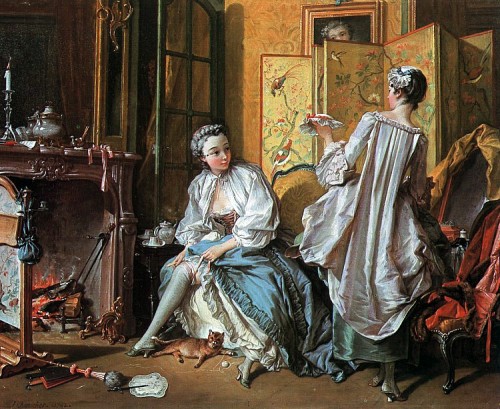My Dr Sketchy talk is themed around how artists were inspired by undergarments. I’m starting with the 18th century and rococo undergarments.
Of course, 18th century undergarments aren’t technically undergarments, since chemises, stays and petticoats could all be worn as outerwear!
So the artworks that I am being inspired by to stage my tableaux for the talk includes both intimate boudoir scenes with real underwear and genre scenes with romanticised peasant women in stays and petticoats.
First intimate boudoir scenes, as epitomised by Boucher’s La Toilette:
Ooh! Stockings! And frilly petticoats! And bed jackets, and maybe a hint of stays. And sexy slippers!
On a much naughtier note, we have Pater’s “Mme. de Bouvillon Tempts Fate by Asking Ragotin to Search for a Flea” (which has got to be the best name for a painting ever, and must be a reference to something)
Mme. de Bouvillon appears to have opened her robe to reveal her jumps, which are barely containing her bounty. Oh dear!
The genre scenes are a little sweeter and less saucy:

François Boucher,Young Country Girl Dancing, Art Gallery of Ontario
Boucher’s dancing peasant girl is improbably pretty, clean, and prettily dressed. I love how her petticoat shows beneath her skirt, and all the bows on her stays.
Vigee Le Brun’s peasant girl is even more romanticised than Bouchers. I love her front lacing stays and the off the shoulder chemise. Besides, the red petticoat is so lovely and vivid.
Watteau also painted dancing peasants in stay bodices:
The one in the red stays appears to have attached sleeves, and once again she has the all important apron.
Even Fragonard, the master of elegantly overdressed women, painted a mother in very unstructured stays:






Maybe it is too early, but what about the 17th-century Windsor Beauties?
You mean Lely’s portraits? Definitely too early for this brief, but if I ever do a 17th century…or need an excuse to show a bunch of women who couldn’t bother getting dressed and wanted to show off a breast or two! 😉
Hahaha! Ok, probably not. I saw them when I was a kid, and always remembered them (…but, but, I thought people in the olden days were more moral or something!) But wasn’t it sort of a trend at the time, being painted in undress?
Gunna ask a question.Daughter is after a black corset what should she know so it fits right?Also she is going as red riding hood to a party is the waist thing you see on these costumes called a cincher or?Hope you can help.
I’ll do a post about what measurements I get from models to make sure a corset will fit them well. I’m not really up on commercial costumes though, so not sure if you are describing a waist cincher or an underbust corset in your second question.
Thanks I think it may be an underbust corset but as I collect and buy costumes I will get both.
Do you have any good resources on terminology for stays/jumps/bodices? Every time I delve into what what called which, I only end up confusing myself more–period dictionaries have all three terms defined nearly interchangeably, and I’ve wondered if there might have been differentation for those garments meant to be worn as underwear only vs those that could be worn as outerwear. I’ve heard modern folk define jumps as partially boned stays, but the period sources I’ve found don’t seem to make that distinction. Any thoughts?
PS I love Boucher’s dancing girl–I’d love to make an outfit like that just to prance about it 🙂
I’ve mostly found the same as you – lots of interchangeable terminology. There seems to have been the distinction that bodices were worn as outerwear (but other than that I can’t find any description of how they were different from stays). There also seems to have been the distinction that jumps were much softer and less supportive than stays, based on people recommending that jumps were more healthful, and that stays reduced the waist too much.
There is also that dreadful piece of doggerel about the girl whose mother wouldn’t let her wear stays, so she committed suicide via a top floor window which includes the line “for want of stays she took to jumps.” I’ve seen that quoted in a number of books.